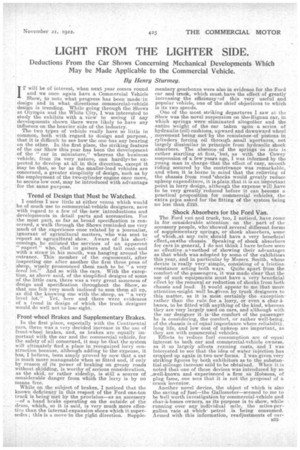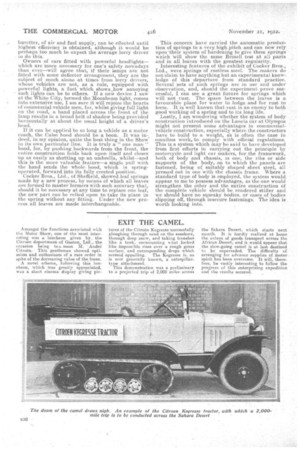LIGHT FROM THE LIGHTER SIDE.
Page 19

Page 20

If you've noticed an error in this article please click here to report it so we can fix it.
Deductions From the Car Shows Concerning Mechanical Developments Which May be Made Applicable to the Commercial Vehicle.
By Henry Sturmey.
IT will be of interest, when next year comes reund and we once again have a Commercial Vehicle Show, to note what progress has been made:in design and in what directions commercial-vehicle design is trending. While going through the Shows at Olympia and the White City, I was interested to study the exhibits with a view to seeing if any developments shown there were likely to have any influence on the heavier side of the industry. The two types of vehicle really have so little in common, both with regard to design and purpose, that it is difficult to see how the one .has any bearing on the other. In the first place, the striking feature of the car Show this year has been the development of the " car in miniature," -whereas the business vehicle' from its very nature, can hardly be expected to develop at all in this direction, except it may be, that, so far as the smaller-load vehicles are concerned, a greater simplicity of design, 'such as by the employment of the two-cylinder engine once more, to secure low cost, may be introduced with advantage for the same purpose.
Trend of Design that Must be Watched.
I confess I saw little at either venue which would be of much use to commercial-vehicle designers, save with regard to a few of the new introductions and developments in detail parts and accessories. For the most part, so far as broad specification is concerned, a walk through the Shows reminded me very much of the experience once related by a journalist, ignorant of agricultural matters, who was sent to report an agricultural show. Aware of his short: comings, he enlisted the services of an apparent " expert " who, clad in gaiters and tail coat=and with a straw in his mouth, was hanging around the entrance. This member of the cognoscenti, after inspecting one after another the first three pens of sheep, wisely pronounced theni each to be " a very level lot." And so with the cars. With the exception, as above said, of the simplified designs of some of the little cars, there was a very great sameness of design and specification throughout the Show, so that one felt ,very much inclined•to sum them all up, as did the knowing one with the .sheep, as "a very level lot." Yet, here and there were evidences of a trend in design of which the truck designer would,do well not to lose sight.
Front-wheel Brakes and Supplementary Brakes.
In the first place, especially with the Continental Cars, there was a very decided increase in the use of front-wheel brakes, and, as brakes are equally important with the car and the commercial vehicle, for the safety of all concerned, it may be that the system. will ultimately find a place in recognized lorry construction because, although adding to the expense, it has, I believe, been amply proved by now that a car is much more manageable when so fitted and, if only by reason of its power of braking on greasy roads i without skidding, s worthy of serious consideration, as the skid, or rather sideslip, is still a source of considerable danger from which the lorry is by no means free. .
While on the subject of brakes, I noticed that the known deficiency in this respect of the Ford one-ton truck is being met by the provision—as an accessory —of a band brake operating on the outside of the drum, which, so it is said, is very much more effective than the internal-expansion shoes which it supersedes ; this is a move in the right direction. Supple, meatary gearboxes were also in evidence for the Ford car and truck, which must have the effect of greatly increasing the efficiencyaof this very useful and popular vehicle' one of the chief objections to which is its two speeds.
One of the most striking departures I saw at the Show was the novel suspension on theellignan car, in which springs were eliminated altogether and the entire weight of the car taken upon a series of hydraulic (oil) cushions' upward and downward wheel movement being met by the resistance-of pistons in cylinders forcing oil threngh small apertures not largely dissimilar in principle from hydraulic ;hock absorbers. The absence of the springs in, toto is rather startling at first, but, as with. the Cowey suspension of a few years ago, I was informed by the young man in chargethat the effect of easy, smooth riding secured by. the contrivance was remarkable, and when it is,borne in -mind that the relieVing of the chassis from road 'shocks would greatly reduce upkeep expenditure, it is plain .that it is an important point in lorry design, although the expense will have to be very greatly reduced before it can become a practical proposition for commercial vehicles, the extra price asked for the fitting of the system being no less than £225.
Shock Absorbers for the Ford Van.
The Ford van and truck, too, I noticed, have come in for considerable attention on the part of the accessory people, who'showed several different forms of supplementary springs, or shock absorbers, some of which.,at any rate should have a very beneficial effectonsthe chassis." Speaking of shock absorbers for cars in general, I do not think I have before seen so effective , aernethod of showing their advantages as that which was adopted by some of the exhibitors this year, and in particular by Messrs. Smith, whose device is really verysimple, consisting of a friction resistance acting both ways. Quite apart from the comforteof the.passengere, it was made clear that the use of such•equipments must have a very beneficial effect by the removal or reduction of shocks from both chassis and load. It would appear to me that more attention might well bcegiven by truck designers to this matter, as it is most certainly the exception rather than the rule for a lorry, or even a char-he banes, to be fitted with anything of the kind, whereas they are very largely used on cars, and although with the car designer it is-the comfort of the passenger he is. considering, the comfort, or rather well-being, of the chassis is of equal importance where reliability, long life, and low cost of upkeep are important, as they are with commercial vehicles. Efforts to reduce fuel consumption are of equal interest to both car and commercial-vehicle ownees, as it so largely affects running costs, and I was interested to see that the idea of water injection hag crwped up again in two new forms. I was given very striking figures by both exhibitors as to the substantial mileage increase said to be obtained. When it is noted that one of these devices was introduced by so ...well-known and experienced a firm as Hobsons, of plug fame, one sees that it is not the proposal of a crank inventor.
Another novel device, the object of which is also the saving of fuel—the Gallometer—seemed to me to be Well worth investigation by commercial-vehicle and char-h-brence owners, as its purpose is to show, while -running over any individual mile, the miles-pergallon rate at which. petrol is being consumed. Armed with this information, readjustments of earB35 buretter, of air and fuel supply, can he effected until highest -efficiency is obtained, although it would be perhaps too much to expect the average lorry driver to do this,
Owners of cars fitted with powerful headlights— which are 'more necessary for one's safety nowadays than ever—will agree that; if their lamps are not fitted with some deliector arrangement, they are the subject of much abuse at times from lorry drivers, whose vehicles are not, as a rule, equipped with powerful lights, a fact which shows,_how annoying such lights can be to others. If a new device I saw at the White City, termed the Moonbeam light, comes into extensive use, I am sure it will rejoice the hearts of eouninercial-vehicle men, for, whilst giving full light on the road, a band placed across the front of the lamp results in a broad belt of shadow being provided horizontally at about the usual height of a driver's hoad.
If it can be applied to so long a vehicle as a motor coach, the (liaise hood should be a boon. It was indeed, in my opinion, quite the best thing in the Show* in its own particular line. It is truly a " one man " hood, for, by pushing backwards from the front, the entire construction folds back upon itself and closes up as easily as shutting up an umbrella, .whilst—and this is the more valuable feature—a single pull with the hand sends the whole hood, which is springoperated, forward into its fully erected position.
Cocker Bros., Ltd., of Sheffield, showed .leaf springs made by a new process, by means of which all leaves are formed to master 'formers with such accuracy that, should it be necessary at any time to replace one leaf, the new part can be relied upon to take its place in the spring without any fitting. Under the new process all leaves are Made interchangeable.
This concern have carried the . automatic production of springs to a. very high pitch and can now rely upon-their System of hardening to give them springs which Will show the same Brinell test at all .parts and in all leaves with the greatest .regularity.
Interesting features of the exhibit of Cocker Bros., Ltd., were springs of rustless steel. The makers do not 'claim to have anything but an experimental know-. ledge of this departure from standard practice. Several sets of such springs are in use and under observation, and, should the experiment prove successful, I can see a• great future for springs which will not rust. The space between the leaves is a favourable place for water to lodge and for rust to form. It is well 'known that rust is an enemy to both
good working of a spring and to its long-life.
Lastly, I am wondering whether the system of body construction introduced on the Lancia car at Olympia might not present some advantages in commercialvehicle construction, especially. where the constructors have to build to a weight, as is often the case in omnibus work,. to comply with official regulations. This is a system which may be said to have developed from first efforts in carrying out the principle by motorcycle and light car makers, for, the framework, both of body and chassis, is one, the ribs or side supports of the body, on to which the panels are fastened, being of suitably shaped sheet steel, all pressed out in one with the chassis frame. Where a standard type of body is employed, the system would. appear to me to possess advantages, as the one would strengthen the other and the entire construction of the complete vehicle should be rendered stiffer and. we should have no squeaky bodies, or eases of bodies slipping off, through insecure fastenings. The idea is., worth looking into.






























